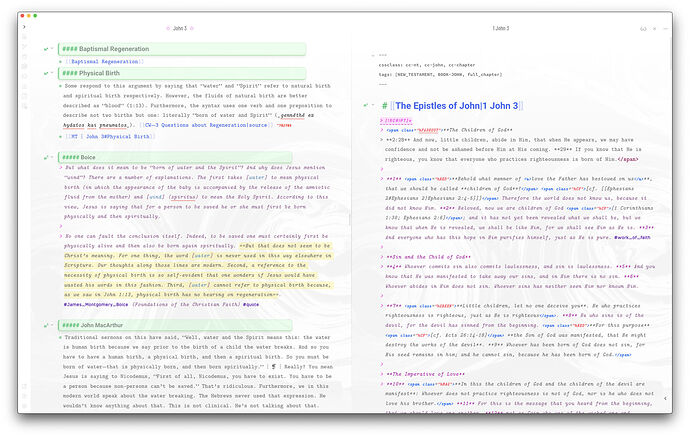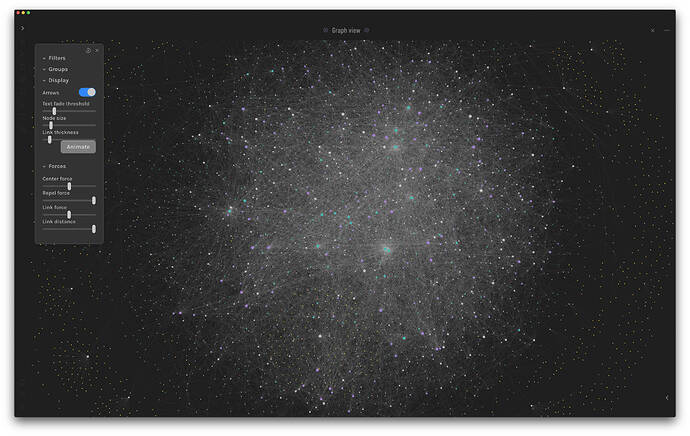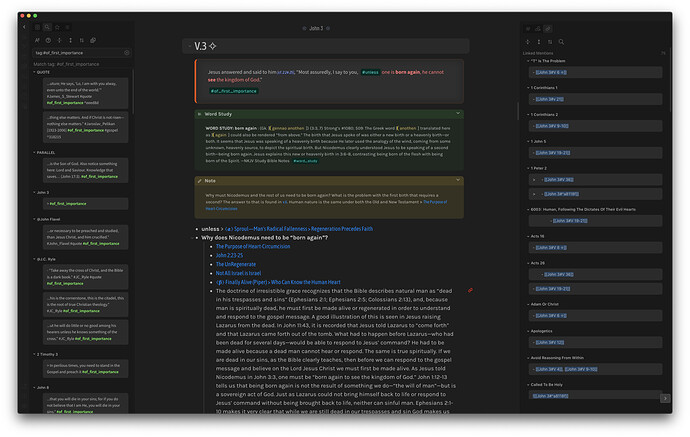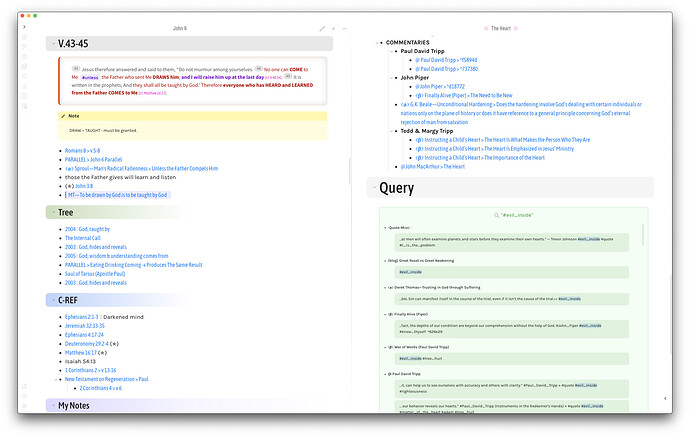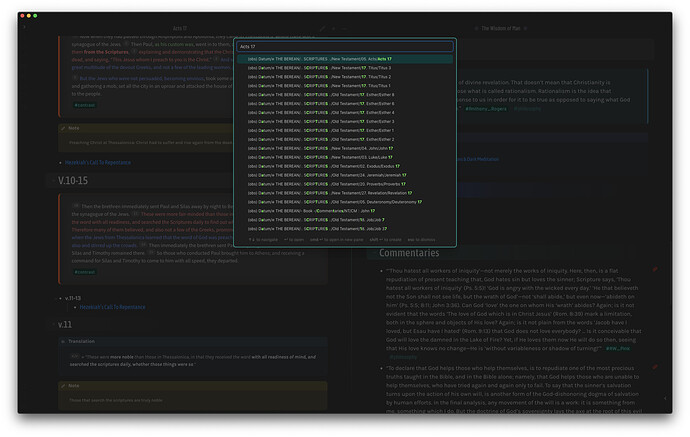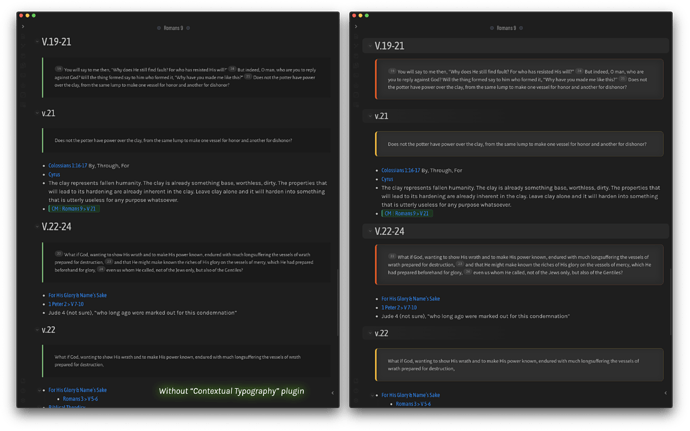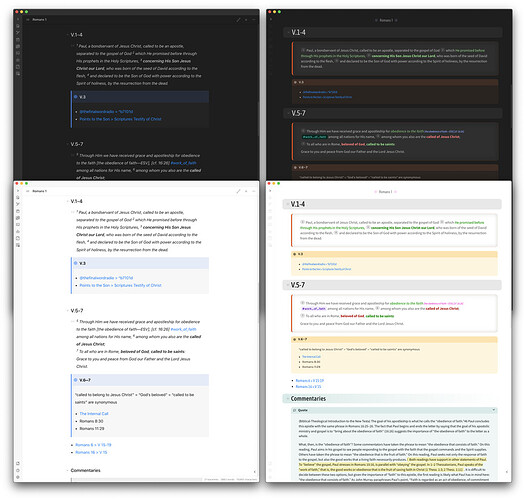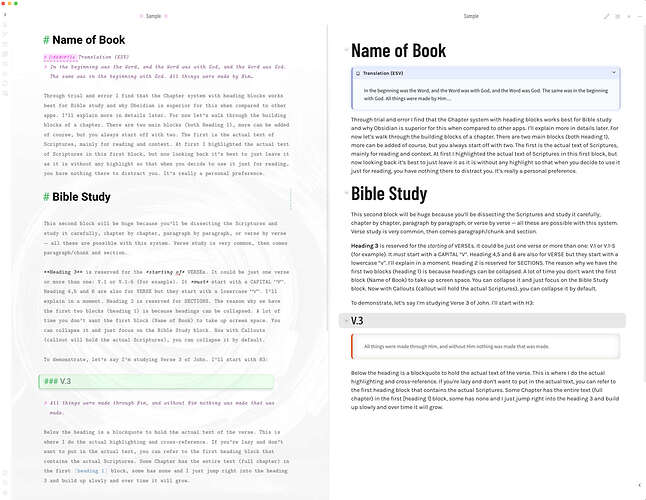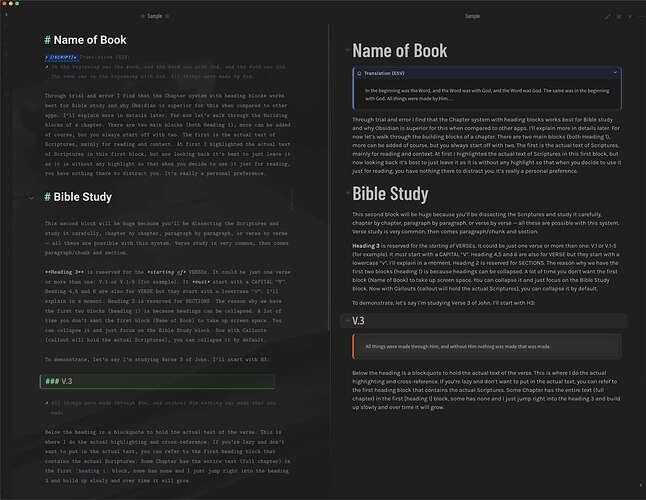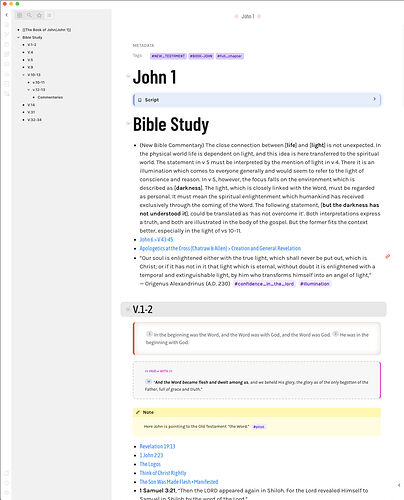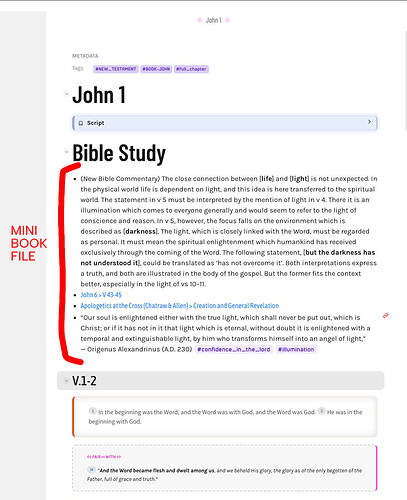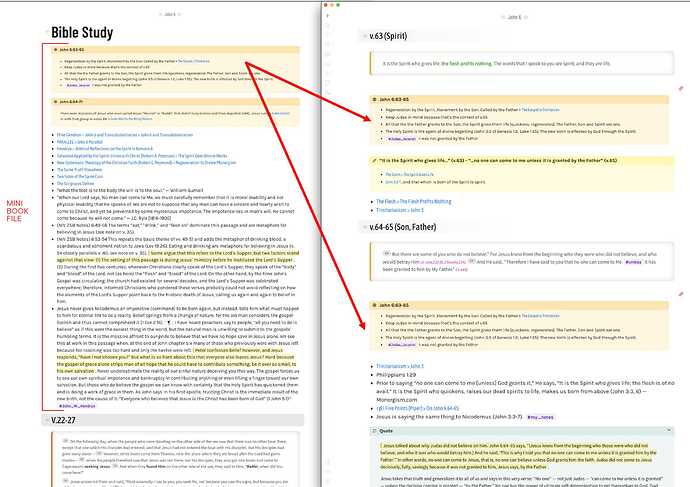Here to share my Bible Study workflow. Samples:
Don’t know where to begin, so if you’re curious and would like to get started, feel free to ask any question about the workflow.
This is amazing!
But I’m more interested and would love to borrow your theme/CSS.
What plugins, if any, do you use for your workflow?
What plugins, if any, do you use for your workflow?
When it comes to plugin I keep it to the minimum for two reasons: 1) Security 2) Don’t want to be locked into plugins and depend too much on them. With that said, the one that is a must for me is the Contextual Typography by mgmeyers. Previously I stored all my notes using OmniOutliner (OO), but it got to the point of lagging (randomly when typing cause it’s a huge database of notes). Also, an outliner isn’t the best way to connect theological dots!
I found out about Obsidian during the lockdown. Gave it a few try and gave up because I didn’t see how I could transfer all my OO data to Obsidian, considering that Obsidian isn’t an outliner. But I needed to move away from OO and wanted something that is a bit more open and cross-platform. Eventually I came back to Obsidian because it’s the only option. At first it was very frustrating because if I can’t highlight notes, and skin the look a certain way, it’s not possible to make a switch because OO looks much more minimalistic and clean! Then I found out about Contextual Typography and with a bit of CSS experience, I was able to slowly build up something that looks very pleasant to the eyes. Before the introduction of CALLOUTS, I made use of the Contextual Typography heavily. By placing a tag inside a blockquote I was able to style that blockquote. Any blockquote with a specific tag will get a unique look. Now I use the built-in Callouts for all that, but I still need the the plugin for styling headers contextually. I believe this plugin should be hardcoded into Obsidian by default.
Contextual Typography and Outliner by Viacheslav are the two plugins I use daily.
I’m not a CSS expert, but I know enough CSS to make changes and to look things up and experiment to find out. Didn’t want to build one from scratch (it’s a lot of work), so I found the “California Coast” to be an excellent starting point for modification because of its minimalistic look for the GUI. However, the typography and overall look need a lot of improvements for my specific needs! Maybe I’ll release a theme someday once I put in the time to explore to find out how the GUI components can be skinned. For now, my mods are mostly for the typography and and general look/feel. I only found out about the “Toggle Live Preview/Source mode” yesterday. I kept everything in one CSS file, but now that I’m switching to Live Source Mode, I have to make a few changes and while I’m at it, I’m also cleaning up and organizing the mods. For those still interested in my mods as shown here, I’ll release once I have them organized, but you will need the “California Coast” theme. I’m still using the old one…
Nice! Contextual Typography is an interesting plugin. I hadn’t seen that one.
I have been using Obsidian religiously since 2021. Prior to that I used OmniOutliner (OO) and Tree to keep my notes. I had to transfer my OO to Obsidian manually and it’s a very lengthy process that is not 100% complete yet. At first I didn’t know how the transfer would be possible since I was so used to keeping notes in an outline format. Yet even when I used an outliner, I felt something is lacking and wanted more, like block-linking and the ability to travel back and forth between links. I also didn’t know the tool (outliner) was shaping and moulding bad habits in me, and no matter how much I tried to be organized in an outliner, things became even more disorganized as things grew and expanded. Not only that, but looking things up is a nightmare. Sure, it’s good to collect data, but what good is it if you can’t quickly find them when you really need it? A step up would be Roam, but I found out about Obsidian before I heard about Roam. And having used Obsidian I can’t see myself using anything else.
If you’re starting out, give this video a watch: Why Obsidian Will Overtake Roam . When it comes to Bible study I agree wholeheartedly.
Also give this a watch: How I Use Roam Research for Bible Study . If you use Obsidian, you can and will do much more than Roam.
Through trial and error I came up with a methodology that works for me when it comes to Bible study which I’ll share later. I’ll touch on what works and what doesn’t and how to get around it. But today I would like to point out something that Obsidian can improve on, and that is the LOCAL GRAPH. Bible study makes heavy use of linking. One book of the Bible can have innumerable links within its database. It’s because of this that graphs are pretty useless. It’s cool to look at, but it’s useless without context. It turns out that I’m not the only one that doesn’t use the graph (see video above).
My suggestion is to have HEADER graph that gives meaningful context to the graph. In the attached screenshot, let’s use header “V.39” as an example. I’m only interested in what’s linking to V.39. Everything else is a distraction, making it hard to look for things linking to V.39. Obsidian should be smart enough to know which header is the active one, and flood the backlinks panel and the graph with only files linking to the active header.
The second block (H1) - Bible Study - can be named anything. Your name, for example.
I’ll be going at my own pace but if you have any question or confused about something feel free to ask.
Hi?
Your study format is what I’ve been missing! Please do continue ? I just love the way you seem to be on top of your study game.
Whats your overall goal? Do you incorporate spaced repetition to aid recall?
CSBS
Since I’ll be doing walkthroughs and demonstrations, I decided to call it Chapter-Systematic Bible Study (CSBS) for convenience. By default, CSBS makes heavy use of headings, and once you got things setup and ready to go linking things will come naturally and smoothly. I have tried many apps as of this writing and I can say with confident that nothing beats Obsidian when it comes to CSBS. Before coming up with CSBS through trial and error, I have looked at other methods and they all fall short, but then again, no system is perfect and that includes CSBS.
If your goal is just to link to a Scripture verse in your writings such as [1 John 1:3], and you want a quick ref of that verse, then a verse by verse (VBV) system is appropriate. CSBS falls short in that area, but there is a workaround even though verse by verse isn’t it’s main objective. A VBV system will only show you the verse’s text. That’s about it. There’s no notes, commentaries, c-ref (cross-references) that go with the verse’s text. This is why each verse is its own paragraph/line and you can’t really style them nor place them in a Callout for styling. A Chapter system (CSBS) places the entire text of the Chapter into a blockquote, and because of this you can’t really link to an individual verse via block linking. It’s either the whole chapter or nothing. With a VBV system, you can embed a specific verse, but with CSBS you can’t extract a verse from the blockquote that contains the Chapter’s Text, but you can link to a particular verse or group of verses through the use of headings. The point here is that a VBV system is convenient because it’s setup that way for quick reference / embed. Whereas CSBS is for in depth studies of the Scriptures. With VBV you can only link to a verse, with CSBS you can link to a verse but you get much more than just the verse! You get in depth analysis and studies for the verse or group of verses you’re linking to! Another way CSBS gets around the verse linking problem is by just linking to the entire chapter, with the custom name to remind you what verse to look for. Example: [[1 John 1|1 John 3:2]]. CSBS can’t really link to any verse that doesn’t exist as a heading or in some way in a Chapter. If all this sounds confusing, don’t worry. I’ll break them all down as we go through.
With all that said, here’s what you can do with CSBS. When properly setup, you can switch between all three modes without touching the actual file. That is made possible via markup and css. CSBS is versatile and powerful for those that really want to get deep in their theological studies. CSBS isn’t just for the Bible, but for any religious text that requires in depth analysis.
This Chapter system is best for reading and analyzing context for in depth studies. To be continued…
Not sure what you mean?
Oh sorry,I assumed that you’d understand an expression I should have first explained…
My goal for in depth study is not only to link to scripture but also to recall with clarity what I do learn. Thus my need to space out those sessions when I recall what I learn in an effort to retain as much relevant info. as I can. I was wondering if you had any such goals and maybe how you incorporate that into your well established study system? That said , I didn’t come up with this phrase. “Spaced repetition” In the knowledge management community it is a well known concept.
My goal for in depth study is not only to link to scripture but also to recall with clarity what I do learn. Thus my need to space out those sessions when I recall what I learn in an effort to retain as much relevant info. as I can. I was wondering if you had any such goals and maybe how you incorporate that into your well established study system?
The thing with biblical studies is that it’s a vast field. The more you learn the more there is to learn, and you can never exhaust it. It’s a field of study unlike any other in that the Bible is living and active with the Spirit bringing spiritual truth to remembrance and opening our eyes to understand the deeper things of God as we grow in our sanctification. This is why I rarely think about how to retain information, but more about how to record and organize them. I let Obsidian be my second brain of storing and having data organized. I do the collecting and organizing, and the locating part is (I believe) where the bottleneck is. This is why I find that getting to and locating the info is much more important than trying to remember or retain them in this digital age. What good is having all the knowledge but can’t locate them? Or find it when you really need it? When you’re in a heated discussion or debate with others, it’s not a time to conduct research, but to retrieve data to help with the discussion/debate. This is where tagging and Pages come in (more on this later).
Once you have the CSBS setup, you can’t stop connecting theological dots—it’ll become an addiction. You will start to see things coming into your mind and your mind will be flooded with new thoughts, ideas and connections that if you don’t record or put somewhere quickly, you can easily forget them. When I’m away from my computer, I must carry a pen and notepad or record it on my mobile device and later feed the data into Obsidian.
As for retaining info: A lot of what I type here and elsewhere just flow out of me naturally because the stuff I talk about are things I’m passionate about. Studying things I don’t have much interest in, I can easily forget them. But studying things I’m very passionate about, I can talk about it non-stop. Passion and love for the things we’re studying IS, I believe, the KEY to retaining info. But even then we don’t always remember everything, but surely, we do remember “some” thing, right? And that little something IS THE KEY. That little something is the anchor. That little something is the first step of locating what you’re looking for in Obsidian. That little something is the TRIGGER. So instead of remembering everything, I find that “little something” to be enough to remember everything without actually remembering everything. That little something is the key access to my second brain (Obsidian) which remembers everything.
Instead of trying to remember everything, I try to engage with the person I’m responding to. To ask questions, think about what they say, how they say it. To analyze their words etc… or to engage with the environment I’m in. To be free and let go, to be a child again, with curiosity and passion. For me, retention happens when new thoughts and connections are created. New thoughts and connections happen as we engage with the environment we’re in or new ideas we wrestle with. This is why often time when giving a speech, or lecture, new ideas and thoughts came! Even though you carefully planned your speech, profound ideas that you didn’t plan or write down suddenly came into your mind in the middle of giving a speech/lecture.
We’re not a machine that just gather info. We’re spiritual beings, and the info we gathered and believed upon affects us profoundly. As we walk in what we have learned and know, with passion, the info will eventually become part of us and in us. And what our hearts are filled with will eventually come out of our mouths.
You know, I was just about to conclude this post but then a new thought just crossed my mind. Retention might not be a problem, but junk data and inconsistencies in our thinking might be the problem. Good info are there, but our minds are filled with junks that take center stage in our mind. To use health as an example: Our bodies have everything required to heal itself. But when it’s loaded with toxins, it can’t fully function as it should. Take away the toxins and the body will begin to heal itself. Likewise, our minds need to be calibrated daily. How? The study of Scriptures. I’ll stop here because this can get theologically deep.
We’ll talk about that “little” something that helps us access our second brain later.
CSBS [P2]
There are 1189 chapters in the Bible. That means you’ll start off with 1189 files, but you’re not creating 1189 files right away. It only means that you’ll eventually have 1189 files for each chapter of the Bible. Each chapter can fill up very quickly and become bloated because each chapter will contain the full text of Scripture for that particular chapter + commentaries + your notes + misc, which makes it difficult to quickly locate things. And this is where the Outline pane comes in handy because CSBS is header-centric.
Even with the ability to locate, data can take up the screen making it inconvenient to quickly input, sort and organize data. Both commentaries and your own notes will take up a lot of space because they will grow and expand over time. Initially, and especially for small books such as (3 John), you can store everything in the Chapter file. But once you find it difficult to manage, that’s when you need to move them to their own files.
- CSBS
- Books (66)
- Chapters (1189)
- Commentaries (1189)
- Notes (1189)
66 + 1189 + 1189 + 1189 = 3,633 files. There are more files but these are the essential ones. We’ll quickly go through each one.
Book File
The Book file acts as an index and or overview, holding all the chapters together. File name is usually: The Book of… Matthew, John, Acts etc… for Epistles, it’s simply: The Epistles of John etc…
Let’s take the Book of Job for example. At the very top (this is a must for quick navigation via Chapter file) are links to every chapter of the book. From the Book file you can easily and quickly navigate to any chapter. And from any chapter you can quickly go back to the Book file OR navigate to any other chapter within the book easily and quickly because each chapter file is linked to the book it belongs to in its very first heading.
Besides being the index of chapters, Book file also acts as an overview, quick notes, todo, summary etc… Basically anything related to the book of Job goes there. Let’s say you’re reading something and find the info very relevant for your studies on Job. But you don’t know where to input the data yet, you can put it in the book file. Or perhaps there are themes and things about Job in general that doesn’t really fit into any chapter. OR perhaps there are things about Job that you’ll link to often! In that case it’s better to have it in the book file so that chapter files can link to it often. Basically, be creative! Nothing is written in stone here.
Each chapter also has a mini-book file!
You can store things that can be linked to within the chapter file over again and again or just notes about the chapter that it’s hard to put into any specific verse block since they’re broad and have many applications.
To be coontinued…
Oh !
I’ve gotten a few ‘‘aha’’ moments on my first reading of this. How kind of you to explain in such great detail. Would you believe it …am beginning to feel hopeful about my bible study efforts…yes!
To be honest I was worried about this…until I read further down…
Oh my oh my!
This has troubled me forever the bible is so deep and there’s a lot of overlapping that would make me feel dizzy trying to record properly…this book file index gives structure as well as freedom…wow…
This has been my struggle as well because His words are exceedingly broad as pointed out by the psalmist (119:96). There are many overlaps, and like John said, our Obsidian would not be able to contain it all (John 21:25). We can still try for our own growth and sanctification. So what’s the best way to logically organize them? Some study chapter by chapter and looking at things as a whole without getting into too much details. Chapter study is more like an overview/summary. It’s at the top looking down. Some study section by section. For example:
- V.1-5
- V.6-7
- V.8-18
- V.19-30
Notice that no verse is missing. But, what if V.5 and V.19 are meant to be studied together? How are you going to group it? Do you suddenly have: V.5,19 as one separate heading?
- V.1-5
- V.6-7
- V.8-18
- V.19-30
- V.5,19
That kind of mess up the natural floating of the headings no matter where it’s placed. How about you want to study V.10-13, when you already have V.8-18? OR, what if you’re starting out studying V.10-13, but then later will study V.8-18 as one big section? What do you do? You already have V.10-13 as one heading, how will V.8-18 fit into all that… as another separate heading? This is the kind of overlapping that makes it difficult for those that are very serious with biblical studies. But for me, I find the most annoying overlap to be this:
- V.1-5
- V.6-10
Suppose later down the road, I want it to be V.5-10! How do I combine V.1-5 and V.6-10 together? Do I suddenly make it:
- V.1-4
- V.5-10 ?
There are a few methods I have come up: Pairing, Parent-Child verse etc… to solve these hiccups. That’s why there’s a [V.] and [v.] (notice the capitalization). We’ll discuss more of this later.
